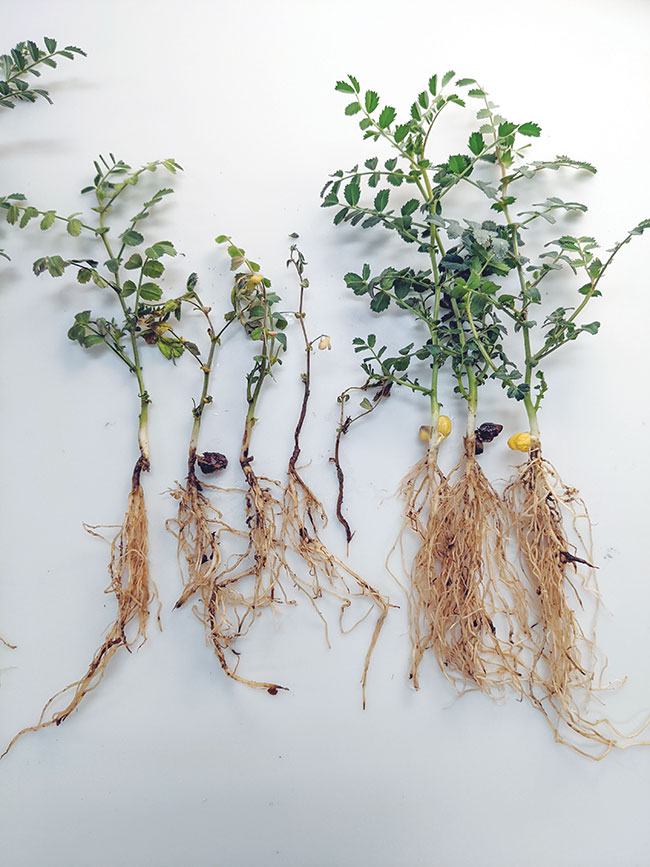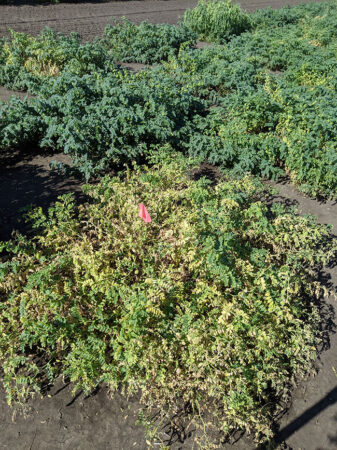
Features
Diseases
Pulses
Arming chickpea to fight off root rot
Identifying the most worrisome pathogens and finding resistant chickpea lines.
January 31, 2024 By Carolyn King
 Chickpea plants infected with root rot (left) compared to healthy chickpea plants (right).
PhotoS courtesy oF Crop Development Centre, University of Saskatchewan.
Chickpea plants infected with root rot (left) compared to healthy chickpea plants (right).
PhotoS courtesy oF Crop Development Centre, University of Saskatchewan. Chickpea root rot is very tough to manage. So, when plant pathologist Sabine Banniza saw root rot popping up in her University of Saskatchewan chickpea disease nurseries a few years ago, she initiated a project to dig into the problem.
About chickpea root rot
“Just as in lentil and pea, a complex of pathogens causes root rot in chickpea,” notes Banniza. “In lentil and pea, Aphanomyces is a very important pathogen in those root rot complexes. But in chickpea, Fusarium species are most important.”
Studies show chickpea has high partial resistance to Aphanomyces root rot, a major disease in Prairie lentil and pea crops. Unfortunately, various other root rot pathogens are able to attack chickpea.
Root rot symptoms in chickpea vary depending on which particular pathogens are involved. Symptoms may include lesions and discoloration of the roots, reduced root mass, as well as stunting and yellowing of the plant’s above-ground parts.
In 2019, not long after Banniza applied for funding for her chickpea root rot project, the chickpea health issue was first detected in Saskatchewan. Since then, Michelle Hubbard, with Agriculture and Agri-Food Canada in Swift Current, has been leading a study to figure out which factors are causing this perplexing problem with its weird mix of symptoms. “I’m sure that root rot contributes to some degree to the chickpea health issue, but I don’t think it is the only factor,” notes Banniza.
Banniza’s chickpea project has a different goal: to identify root rot resistance sources for use in Bunyamin Tar’an’s chickpea breeding program at USask. Steps to achieve this goal include finding out which root rot pathogens are in Saskatchewan chickpea fields, determining which of those pathogens is likely the most important economically and screening chickpea lines for resistance to this pathogen so resistant lines can be passed along to Tar’an’s program.
Which root rot pathogens are out there?
To survey root rot pathogens in commercial chickpea fields, Banniza’s group collaborated with the Saskatchewan Ministry of Agriculture, Saskatchewan Crop Insurance Corporation and Saskatchewan Association of Rural Municipalities.
“In 2020, we did a broad survey right across Saskatchewan’s chickpea growing area,” explains Banniza. “Then in 2021 – because we were really more interested in figuring out which pathogens are important and which ones are associated with high root rot ratings – we focused the survey on the rural municipalities where we saw high root rot in 2020.”
Across the two years, the most commonly detected pathogens on chickpea roots were Fusarium redolens, Fusarium solani and Fusarium avenaceum. Banniza adds, “Those three Fusarium species are also very common in pea and lentil.”
Interestingly, two of the root rot pathogens detected in the surveys had never before been reported on chickpea in Saskatchewan. Those species are Verticillium dahlia and a Berkeleyomyces species. Banniza notes that Verticillium dahlia is a root and stem pathogen that infects some other types of crops grown on the Prairies, and Berkeleyomyces is known as a root rot pathogen elsewhere in the world where the climate is warmer.
According to Banniza, finding these unexpected microbes might just be the result of intensively looking specifically for such species with the help of PCR technology. However, the occurrence of these species may also be an indication of a change in the spectrum of soil pathogens, perhaps due to changes in environmental factors like warmer soil and air temperatures or earlier warming of the soils, which can favour certain species.
Which pathogen is the biggest threat?
“You can often recover many different species from roots. This doesn’t mean that each and every one of them is a serious pathogen. Sometimes, as the roots are starting to rot away, some species just infect as a secondary organism,” Banniza explains.
So, her research group conducted indoor testing to assess the potential of the different pathogens to cause root rot in chickpea.
“We found, for example, that although we often see Fusarium redolens and Fusarium solani on chickpea roots, they most likely don’t cause a lot of disease. However, with Fusarium avenaceum, some but not all isolates are quite virulent on chickpea,” she notes.
In addition, isolates of two of the less frequently detected species, Fusarium culmorum and Verticillium dahlia, were fairly virulent on chickpea.
Screening for resistance
Because Fusarium avenaceum is common on chickpea roots and also has some variants that are quite virulent on chickpea, Banniza’s research group decided to focus on this pathogen for the chickpea screening work.
Her group is currently screening a wide range of desi and kabuli chickpea lines for resistance to Fusarium avenaceum, under controlled growing conditions. By the time the project is completed in spring 2024, they will have screened a few hundred lines.
In addition, they are also screening wild relatives of chickpea. “Sometimes you can find really good, durable disease resistance in wild relatives,” notes Banniza. “Bunyamin Tar’an’s breeding program has already been working with wild relatives for Ascochyta blight resistance.”
She adds, “Once we’ve finished the screening with Fusarium avenaceum, we will discuss with the breeder whether we should consider screening for chickpea resistance to Fusarium culmorum or maybe Verticillium dahlia.”

Above-ground symptoms of chickpea root rot.
Promising findings
For both desi and kabuli chickpeas, Banniza’s research group has already found some lines with pretty good resistance to Fusarium avenaceum.
“On the kabulis, the most resistant lines may have 50 to 60 per cent less disease than the most susceptible lines. And on the desis, we have some lines that show very little disease. That is very promising,” says Banniza.
“We will pass along the lines with higher resistance to Bunyamin so he can start using them in his crosses to move the resistance into his germplasm and then eventually into cultivars. But that is a long process; from the cross to seeds in farmers’ hands often takes 10 years.”
Tips for growers
In the meantime, the information coming from this project about chickpea root rot pathogens could help growers in planning how to deal with the problem. “Knowledge of what species are present and which ones are more virulent is important for growers. For instance, for managing Aphanomyces, we are talking about crop rotations,” says Banniza. “However, Fusarium avenaceum is an important pathogen in pea, lentil and chickpea, so crop rotation may not be a very effective means of managing that disease.”
Seed treatments can help, but they are not a complete solution. “There are seed treatments for Fusarium, but the purpose of the seed treatments is to ensure that the seed germinates and the seedling establishes. These products usually have an efficacy of three or maybe four weeks. However, many of the root rot pathogens can infect roots throughout the entire growing season.”
Until chickpea varieties with better root rot resistance become available, Banniza’s main recommendation to farmers is “to do everything they can to make the soil ecosystem as healthy as possible. For instance, even if crop rotations do not specifically break the lifecycle of a pathogen like Fusarium avenaceum, rotations can influence the general diversity of the microbes in the soil and soil health. And that may promote antagonistic microorganisms that may contribute to dampening down these pathogens.”
Banniza’s chickpea root rot project is funded by the Saskatchewan Agriculture Development Fund and the Western Grains Research Foundation.